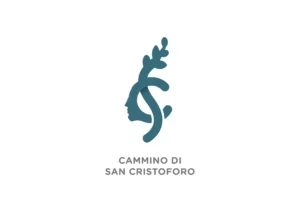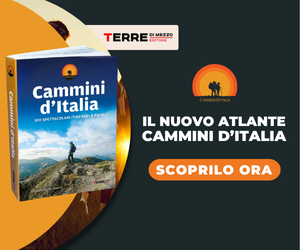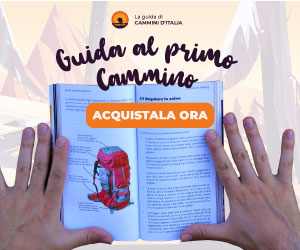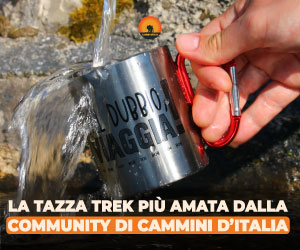
Cammino di San Cristoforo - La Pedemontana
The beating heart of the Cammino di San Cristoforo – LA PEDEMONTANA is a journey that invites you to discover Western Friuli with new eyes, crossing an area where history, nature and traditions come together to provide unforgettable emotions.
The Pedemontana is one of three routes of the Cammino di San Cristoforo - La Pedemontana, an itinerary of more than 350 km that crosses 25 municipalities in Western Friuli. It is a journey through spectacular landscapes, history and traditions, where art and nature merge with the evidence of a millenary culture.
The path winds between two UNESCO Sites-the Neolithic pile-dwelling site of Palù di Livenza and the Friulian Dolomites-and includes places of rare beauty such as the Magredi and the historic villages of the piedmont, enriched by castles, churches and traces of a past ranging from prehistory to industrial archaeology. It is an itinerary that invites you to immerse yourself in the biodiversity of the area and to meet the local communities, whose hospitality makes the experience even more special.
The Pedemontano Route
La Pedemontana stretches over 150 km, connecting Caneva to Spilimbergo in 9 STAGES. It is the heart of the Cammino di San Cristoforo, an itinerary that crosses the two great symbolic rivers of western Friuli: the Livenza and the Tagliamento.
The Livenza, once a natural bridge between the Veneto and Friuli, and the Tagliamento, the last wild river in Europe, define a route that combines landscapes, flavors and stories. This piedmont section follows a ridge that opens the view to hills and mountains, dotted with villages and hamlets. The villages, separated by forests and paths, tell of a cultural multiplicity reflected in dialects, architecture and local traditions.
Between nature and culture
Along the Foothills, you will discover unique biodiversity and landscapes shaped over the centuries by rivers. Hills, valleys and streams hold stories and legends, such as those of the agane, spirits of the waters that still populate the local imagination.
In addition to natural beauty, the route offers an authentic food and wine experience: dishes and wines that reflect the deep connection between the creativity of the inhabitants and the richness of the land. The Pedemontana is a journey through history, nature and traditions that turns every step into an unforgettable experience.
Data Sheet
-
Length:
159,3 km -
Stages:
9 -
Departure:
Caneva -
Arrival:
Spilimbergo -
Ideal period:
Year-round
HISTORY
The Cammino di San Cristoforo in Friuli Venezia Giulia, was born in 2018 by the happy intuition of Dr. Forestry Luisa Cappellozza and Architect Giorgio Viel, with the desire to create connections between the valleys already served by the pedemontana railway and the FVG3 bike path, enhancing the landscape, historical and artistic beauty of the area, from the Livenza to the Tagliamento, the last wild river in Europe.
Montagna Leader immediately seized the opportunity to give space to this project by investing in ideas and professionalism, and today as the managing body of the Cammino it coordinates the various initiatives, putting at the center the economic and cultural operators and the communities that are increasingly open to welcoming walkers.
The Cammino di San Cristoforo is listed on the FVG Registry of Paths and in the Catalogue of Italian Religious Paths of the Ministry of Tourism.
It is dedicated to St. Christopher, the patron saint of travelers, pilgrims and walkers, who with his staff fords the river carrying the Child on his shoulder (Christopher=bearer of Christ). He is depicted on the outside and inside of many churches along the path and near fords, to protect and benevolently welcome anyone who sets out on the journey.
The more than 100 churches and parish churches present offer pilgrims moments of spirituality and recollection in pleasant places and oases of peace. Each one preserves a vast heritage of works of art, the result of a centuries-old school of painting and sculpture that reached its peaks with masters such as Giovanni Antonio de’ Sacchis called the Pordenone, Pomponio Amalteo, Gasparo Narvesa, Giovanni Francesco dal Zotto called Gianfrancesco da Tolmezzo, Marco Tiussi da Spilimbergo, Giovanni Antonio Bassini called the Pilacorte, and Ghirlanduzzi.
WATER SOURCES.
Present in abundance along the Foothills Trail, the entire route passes through villages and hamlets.
SERVICES
At each STAGE there are small towns where you can find small grocery stores or supermarkets. There is also the possibility of buying typical and local products directly from the businesses along the way.
PHARMACIES:
- Stevenà di Caneva (2)- Polcenigo (2)
- Polcenigo (2) – Budoia (1) – Aviano (3)
- Aviano (3) – Malnisio di Montereale Valcellina (1)
- Malnisio di Montereale Valcellina (1) – Maniago (3)
- Maniago (3) – Frisanco (1) – Meduno (1)
- Meduno (1) – Travesio (1)- Castelnovo del Friuli (1)
- Castelnovo del Friuli (1) – Clauzetto (1)- Anduins di Vito d’Asio (1)
- Anduins of Vito d’Asio (1) – Pinzano al Tagliamento (1)- Valeriano
- Valerian – Spilimbergo (4)
SIGNAGE
The signage on the Camino di San Cristoforo is clear and well-organized to accompany you step by step along the percorsoio. Here’s what you’ll find:
- Directional: 20×10 cm tables with a brown background and the color of the path you are following (yellow for the Pedemontana, green for the Magredi Path, blue for the Meduna Valley Ring). Each table includes the Cammino logo and a directional arrow accompanied by the location to be reached.
- Signposts: 10×15 cm tables with background of the color of the path. These also bear the logo of the Way and are often fixed on poles or trees, following their natural shape to blend into the environment.
- Studs: 11 cm diameter bronze plates with the logo and directional arrow embossed on them. These particular markers are found in places where traditional supports are lacking and are fixed on walls or directly on the roadbed.
ROAD BOTTOM.
64% asphalt
36% trail/terrain
The route is on:
33% roads inhibited to vehicular traffic
55% roads with little vehicular traffic
CREDENTIALS
MANDIpass is the credential for the Camino and is free.
Available at the PromoTurismoFVG office in Pordenone, the IAT offices in Maniago, Spilimbergo, Toppo di Travesio, Tramonti di Sopra, the Albergo Diffuso in Clauzetto, Polcenigo, Vivaro, Tramonti di Sotto, and the Community Cooperative Together in Meduno,
CONTACTS
Mountain Leader Association Scarl
Via Venezia, 18/c
33085 Maniago (Pn)
gal@montagnaleader.org
tel. 0427 71775
STAGE 01
STAGE 01: Stevenà – Polcenigo
Length: 18.7 km
The itinerary begins by revealing two jewels of extraordinary beauty and historical importance: the UNESCO site of Palù di Livenza, one of the oldest pile-dwelling sites in Italy dating back to 5,000 B.C., and the San Floriano Rural Nature Park, a green oasis that combines nature, biodiversity and cultural initiatives.
Along the way, the hilly landscape, enriched by olive trees and local plants such as the figomoro of Caneva, will gently accompany you. From Palù di Livenza, with its millennial charm, you will reach the San Floriano Park, a place of peace and enhancement of local agricultural traditions.
There is no shortage of traces of local culture, such as the Sanctuary of Our Lady of Persego in Stevenà, linked to folk cults, and the remains of the medieval castle in Caneva, which offer breathtaking views of the Friulian and Veneto plains.
Polcenigo, listed among the “Most Beautiful Villages in Italy,” concludes the stretch with its unique charm: old stone houses, aristocratic villas, narrow alleys and the Livenza River running through the main square. Here, echoes of the Middle Ages and Renaissance intertwine with Venetian architecture in a village that today is a draw for tourists from all over the world.
STAGE 02
STAGE 02: Polcenigo – Aviano
Length: 15.7 km
Starting from Polcenigo, one of Italy’s most beautiful villages, the walk takes you along the evocative Gor Trail, a place surrounded by nature among forests and streams, far from the hectic pace of modernity.
Continuing on, you will reach the church of Santa Lucia di Budoia, situated on a panoramic hill overlooking the plain. After a restorative break, you’ll descend toward Budoia with its characteristic stone houses, and you’ll have a chance to visit the hamlet of Dardago, a little gem to explore.
The STAGE ends at Castel d’Aviano, a village steeped in medieval history, with ancient fortifications and a quiet square that invites a relaxing stop, perhaps at an old local tavern.
STAGE 03
STAGE 03: Aviano – Malnisio
Length: 22.9 km
Leaving the center of Aviano with its cathedral dedicated to St. Zeno, the path climbs back up to the foothills. Through a short path in the woods, you will reach Colle San Giorgio, a quiet place with a wide meadow and a small panoramic church that offers views of the foothills of the Alps and the plain.
Continuing on, the route will take you to the Sanctuary of Madonna del Monte in Marsure, an oasis of peace surrounded by nature. Surrounded by hills, woods and cultivated fields, you will cross the stretch between Giais and Grizzo, rich in rural suggestions that evoke an authentic past. The STAGE ends in Malnisio, a few steps away from the beauty of nature and history of the area.
STAGE 04
STAGE 04: Malnisio – Maniago
Length: 9 km
After passing through the center of Montereale, stop to visit the church of St. Roch, protector of travelers and pilgrims, with its frescoes worth a look.
The path then takes you to a unique vantage point: the bridge over the Cellina, where the emerald and turquoise waters held back by the Ravedis dam provide an extraordinary view. From here the CAI trail leads you up, offering a breathtaking view of the Magredi, a vast steppe-like floodplain, a rare and precious environment in northern Italy.
Continuing through the woods, the route descends gently to Maniago, the “City of Knives,” where the STAGE ends.
Grizzo ring digression
Length: 3.3 km
This short loop digression takes you to the “Antonio Pitter” Hydroelectric Power Plant, a work of industrial archaeology from the early 1900s that combines functionality and aesthetics, turning into a true example of beauty in the landscape.
Perfectly preserved, you can visit its turbines, alternators and other original machinery, but today the power plant is also a cultural and scientific hub, home to exhibitions and workshops for adults and children. A place that has evolved from a tool of industrial development to a space for cultural and social growth, offering new energy to the area.
Digression Gravedai – Maniago
Length: 3.7 km
This digression takes you to Maniago through the unspoiled nature of the foothills. It only takes a few steps to leave the main road and immerse yourself in the forests of the foothills, where the slopes provide a perfect space to empty your mind and catch the details that make this land unique: a rock, a tree, a glimpse of a mountain or a play of light.
Amidst tree foliage and sudden clearings, the view opens up to the Cellina riverbed, which cuts through the Friulian plain with its decisive mark. Crossing the Val Piccola, the path takes you to the ruins of the medieval castle of Maniago, once a strategic garrison against invaders, now a place of peace. From here, it is only a short way down to the city.
STAGE 05
STAGE 05: Maniago – Meduno
Length: 17.6 km
Maniago, the “City of Cutlery,” is worth a stop to discover how, since the Middle Ages, craftsmanship and the waters of the Colvera River have given rise to a tradition that still thrives today. Visit the Museo dell’Arte Fabbrile, where modernity and tradition meet, and stroll through the historic center, admiring the cathedral, an elegant example of Romanesque architecture.
Leaving the city, the path climbs into the charming Colvera Valley, a valley that in spring and autumn is dressed in a magical atmosphere, among woods and small villages steeped in stories and legends, such as those of the agane, spirits of the waters. The road leads you to Poffabro, one of the “Most Beautiful Villages in Italy,” where you can lose yourself among alleys, manicured houses and breathtaking views of the valley.
Continuing on, you will reach Frisanco, another jewel of the valley, similar but with a charm all its own, and then Valdistali, to the small hamlet of Preplans, a place that reflects the return of those seeking peace and beauty in these lands. Crossing the Meduna River, you will finally reach Meduno, concluding a challenging but extraordinarily fascinating STAGE.
STAGE 06
STAGE 06: Meduno – Paludea
Length: 14.5 km
After Meduno, the path descends to the plain, crossing fertile fields and hills that stand out against the profile of the mountains. Among them, Mount Valinis, a famous destination for hang gliding and paragliding enthusiasts, offers a spectacle of gliding and circling, flanked by the birds of prey that populate the sky: griffons, eagles, hawks, kestrels and buzzards.
Along the way, you will encounter the remains of the medieval castle of Toppo, a village inscribed among the most beautiful in Italy, which hides its beauty in its alleys and ancient courtyards. Further on, the view opens to a group of lonely hills, like stones dropped by a giant.
Continuing on, you will reach Travesio, where you can visit the Pieve di San Pietro Apostolo, enriched by frescoes by Pordenone and sculptures by Pilacorte. After crossing the Cosa stream, fed by mountain canyons explored by speleologists from all over Europe, the path starts climbing again in the woods, to Vigna, a hamlet of Castelnovo del Friuli. This village, with its more than 30 hamlets, offers a unique panorama from the hill with the remains of the castle and the church of San Nicolò, where the view encompasses both the plains traveled and those ahead.
Almadis Digression
Length: 1.9 km
With a short detour and a small elevation gain, you can reach the old dairy in Almadis, a place that was once a meeting and processing point for simple local wealth.
A few steps are enough to plunge into a gentle, sunny landscape surrounded by the historic hamlets that dot the hills all around.
STAGE 07
STAGE 07: Paludea – Anduins
Length: 14.2 km
This STAGE alternates between ascents and descents through forests and hamlets, such as Celante di Castelnuovo, to Clauzetto, the “balcony of Friuli,” from which the view reaches as far as the Adriatic Sea. Here, the church of St. James recalls a pilgrimage tradition dating back to the 1700s, linked to the relic of the most precious blood of Christ, to which miraculous powers were attributed.
Crossing the woods, you will encounter the ancient parish church of San Martino, with frescoes, inscriptions and a Pilacorte altar that tell of this land’s links to distant cultures. The STAGE continues to Vito d’Asio, a village with characteristic stone houses and cobblestones, until continuing to the surrounding heights.
STAGE 08
STAGE 08: Anduins – Valeriano
Length: 12.8 km
The path descends into the plain, skirting the Arzino stream with its bends, small beaches and emerald waters, set among woods and rocks. This place is perfect for a break and a moment of contemplation.
Continuing on, you will reach Pinzano, where a short climb will give you a unique view of the breadth of the Tagliamento, one of the few rivers in Europe that still flows in its original riverbed, a symbol of unspoiled wilderness. Descending through hills, woods and streams, you will finally arrive in Valeriano.
Digression Germanic Shrine of Pinzano
Length: 1.7 km
A very brief digression takes you to the Germanic Memorial of Pinzano, a walk worth taking, for the panoramic view it offers. You will encounter an unfinished mausoleum, created to hold the remains of German and Austrian soldiers of the Great War, which today becomes an opportunity to admire the lush and generous life around you: in the wildly flowing Tagliamento, in the landscape of mountains and hills, of villages and towns, that tell of a peace beyond wars.
STAGE 09
STAGE 09: Valeriano – Spilimbergo
Length: 8.5 km
The last STAGE of the route is short and downhill, accompanied by a slow pace and the quiet of the countryside. In Valeriano, stop to discover recently rediscovered native wines, to be tasted directly in the place that generated them. Also visit the Church of the Battuti, recognizable by the imposing fresco of St. Christopher on the facade, with other Renaissance works inside, including those by Giovanni Antonio de Sacchis, known as “il Pordenone.”
Resuming the path, you will descend along the banks of the Tagliamento River to Spilimbergo, known as the “city of mosaics” for its internationally renowned Friuli School of Mosaicists. Once you arrive, explore the ancient vestiges of the town, evidence of an important Renaissance commercial and cultural past, the perfect epilogue to the walk.










